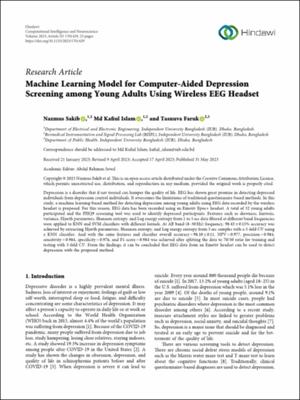| dc.contributor.author | Islam, Md Kafiul | |
| dc.contributor.author | Faruk, Tasnuva | |
| dc.contributor.author | Sakib, Nazmus | |
| dc.date.accessioned | 2023-06-11T06:56:19Z | |
| dc.date.available | 2023-06-11T06:56:19Z | |
| dc.date.issued | 2023-05-31 | |
| dc.identifier.citation | Nazmus Sakib, Md Kafiul Islam, Tasnuva Faruk, "Machine Learning Model for Computer-Aided Depression Screening among Young Adults Using Wireless EEG Headset", Computational Intelligence and Neuroscience, vol. 2023, Article ID 1701429, 23 pages, 2023. https://doi.org/10.1155/2023/1701429 | en_US |
| dc.identifier.issn | 1687-5273 | |
| dc.identifier.uri | https://ar.iub.edu.bd/handle/123456789/558 | |
| dc.description | A Q1-ranked Journal with WoS Impact Factor of 3.633 | en_US |
| dc.description.abstract | Depression is a disorder that if not treated can hamper the quality of life. EEG has shown great promise in detecting depressed individuals from depression control individuals. It overcomes the limitations of traditional questionnaire-based methods. In this study, a machine learning-based method for detecting depression among young adults using EEG data recorded by the wireless headset is proposed. For this reason, EEG data has been recorded using an Emotiv Epoc+ headset. A total of 32 young adults participated and the PHQ9 screening tool was used to identify depressed participants. Features such as skewness, kurtosis, variance, Hjorth parameters, Shannon entropy, and Log energy entropy from 1 to 5 sec data filtered at different band frequencies were applied to KNN and SVM classifiers with different kernels. At AB band (8–30 Hz) frequency, 98.43 ± 0.15% accuracy was achieved by extracting Hjorth parameters, Shannon entropy, and Log energy entropy from 5 sec samples with a 5-fold CV using a KNN classifier. And with the same features and classifier overall accuracy = 98.10 ± 0.11, NPV = 0.977, precision = 0.984, sensitivity = 0.984, specificity = 0.976, and F1 score = 0.984 was achieved after splitting the data to 70/30 ratio for training and testing with 5-fold CV. From the findings, it can be concluded that EEG data from an Emotiv headset can be used to detect depression with the proposed method. | en_US |
| dc.description.sponsorship | This research was funded by IUB Sponsored Research Grant (Ref. #2020-SPPH-01) and supported by the Biomedical Instrumentation and Signal Processing Lab (BISPL) of Department of Electrical and Electronic Engineering, Independent University, Bangladesh (IUB). | en_US |
| dc.language.iso | en_US | en_US |
| dc.publisher | Hindawi | en_US |
| dc.relation.ispartofseries | Computational Intelligence and Neuroscience;Volume 2023 | Article ID 1701429 | |
| dc.subject | Research Subject Categories::TECHNOLOGY | en_US |
| dc.subject | Research Subject Categories::INTERDISCIPLINARY RESEARCH AREAS | en_US |
| dc.title | Machine Learning Model for Computer-Aided Depression Screening among Young Adults Using Wireless EEG Headset | en_US |
| dc.type | Article | en_US |
